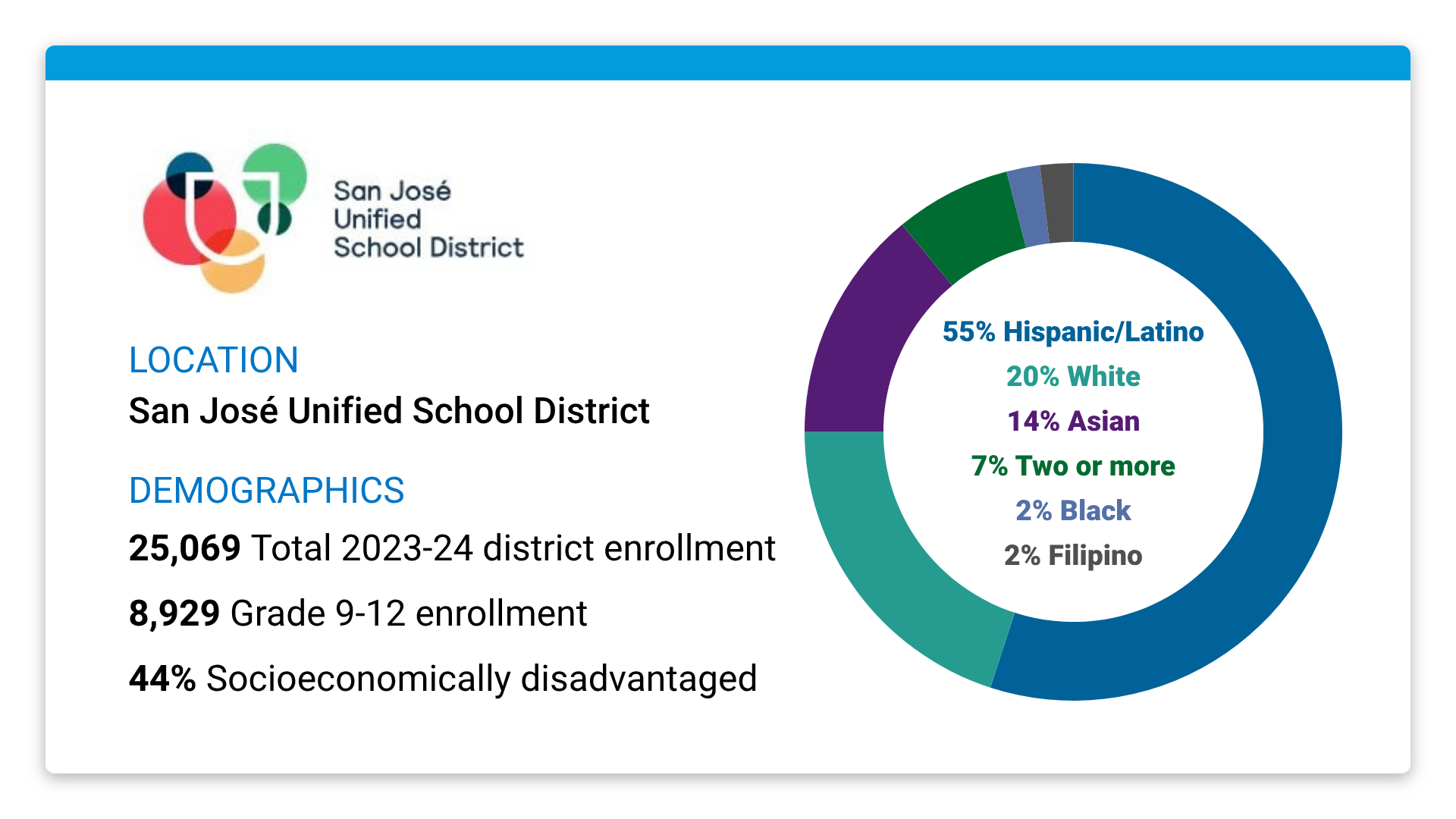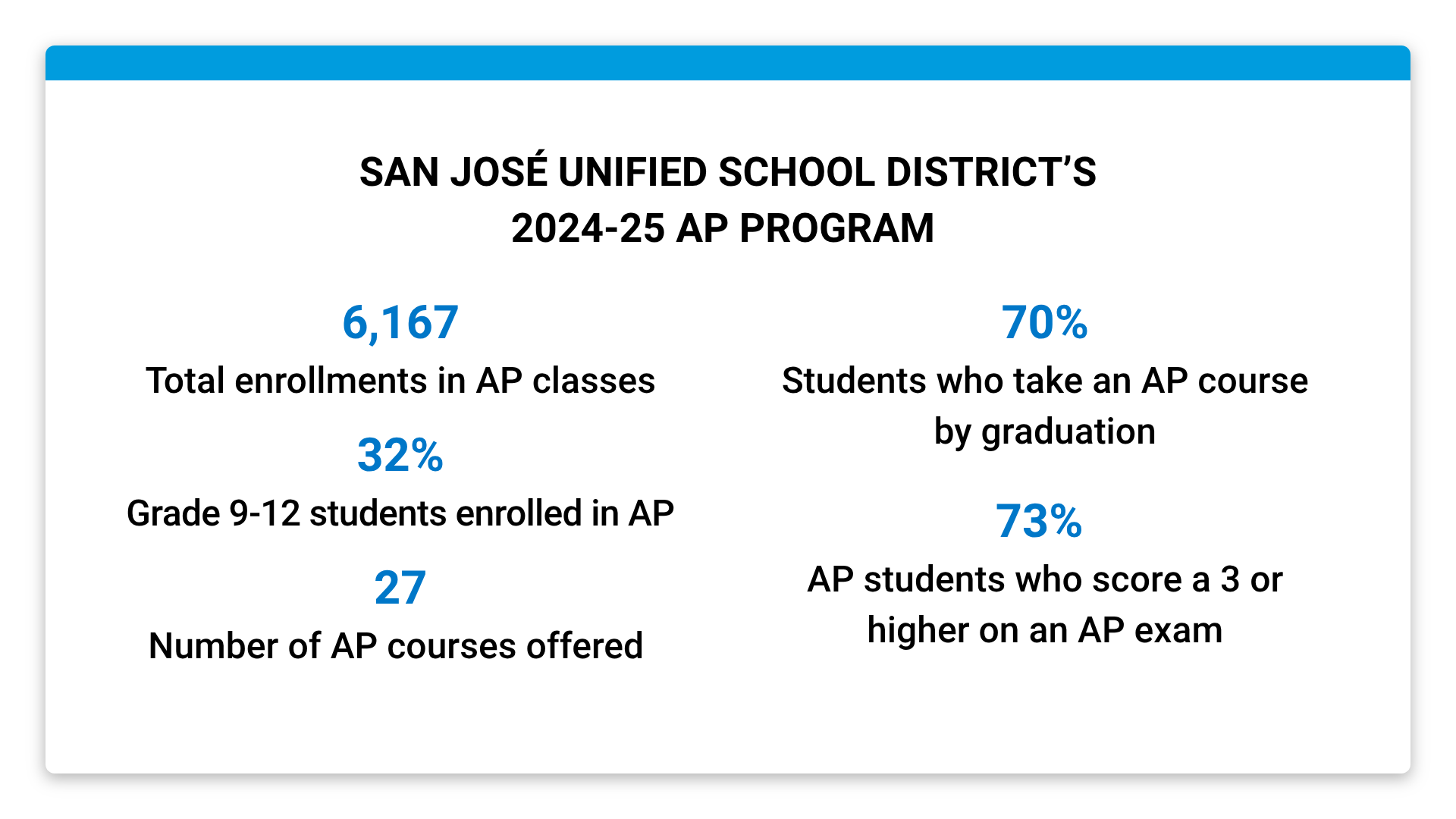Changing Culture to Remove Barriers to Advanced Learning
Expanding advanced learning opportunities is often an evolutionary process that requires patience, persistence, and a commitment to seeing challenges as opportunities. This understanding, along with a steadfast focus on education excellence, allowed our district to boldly and effectively transform culture and significantly impact educational equity.
Identifying the Opportunity
The San José Unified School District sits in the midst of Silicon Valley. Yet, in spite of the influence and privilege that surround us, our demographics suggest otherwise. Eighty percent of our 25,000 K−12 students are from underrepresented communities, and 44% are considered high need.
Couple that with our history. In the 1980s, we were one of the first school districts in the nation to declare bankruptcy, and we faced leadership turmoil. By the 1990s, we had new leaders at the helm, and we set a path toward education excellence. Our mission “Uniting as one community, we elevate opportunities for all” began to take shape. Thus, the need to ensure all students had access to advanced learning and could graduate college ready became our central concern.
Now, our commitment to removing barriers to equity drives our work. Because we successfully resolved resource allocation challenges, we were able to clear cost hurdles associated with taking Advanced Placement® courses and exams. All of that required us to focus on three areas: culture, data, and access.
“We worked collaboratively with our teachers, our teacher leaders, and our labor leaders to really change the perception of what an AP classroom looks like.”
Nancy Albarrán, Superintendent
Turning Opportunity Into Action
First, we dug into our culture. After all, we believe attitude is just as important as aptitude. To secure “buy-in” from our teacher community, we had to change perceptions about what an AP classroom looks like and provide professional learning opportunities. We did this so all teachers would become confident and be motivated to teach AP. Our hiring has even evolved. We now focus on choosing educators who believe all students can learn and achieve greatness.
Next, we gathered the data. To broaden the population of students taking AP, we identified students who were ready by getting teacher and counselor recommendations, looking at grades, and leveraging the AP Potential™ tool.
To extend access, we added more AP courses to the roster. We also had to prioritize the financial support needed to accomplish all of this. We made sure our budgets included support for AP summer boot camps for students, professional development for teachers, and a policy to pay for all AP and SAT exams.
“Through AP Seminar, students have increased opportunities to access an AP course that they otherwise might be apprehensive about. They learn valuable skills to research a problem and present solutions.”
Erin Cahill, Assistant Principal, Pioneer High School
Evaluating the Outcomes
We strive for our AP program’s student population to reflect the demographics of our district, in which approximately 80% of students are minorities. We’re now close to achieving this goal, and minority students make up 70% of all AP participants.
Our diverse AP program is thriving: 70% of all students take an AP course by graduation, and 73% of AP students score 3 or higher on their AP Exams. Notably, 60% of the graduating class of 2024 took AP courses and earned qualifying scores of 3 or better. Additionally, five schools have been recognized on the AP School Honor Roll.
In San José Unified, we have a maxim: We need to know every student by name, strength, and need. Then we must play upon those strengths to change outcomes.
To administrators considering strategies to enhance advanced learning, we say this: It’s easy to get distracted by the day-to-day noise, but ultimately it’s important to continually redirect your attention to the nucleus of your system: the classroom. Then mobilize resources to make sure both your teachers and your students can be successful.
Practical Pointers
- Striking Balance: Ensure that each school has budget and staffing in place to reflect the students in their charge. Schools with large high-needs populations should be budgeted and staffed to adequately support their students.
- Collaboration: Often, schools that demonstrate the greatest success are those where the principal, counselors, and teachers work together to tell every student they know what they’ll need to be successful in the classroom.
- Students as Influencers: Current AP students can be effective ambassadors in your recruitment efforts. As trusted allies, they can uniquely persuade and encourage their peers.
To learn more about San José Unified’s efforts, watch this webinar.
Educator Perspectives
“We focused on culture, data, and financial support to create opportunities for students. It’s really important to prioritize the financial support needed. We pay for all AP and SAT exams because we want to make sure we eliminate as many barriers as we control.”—Nancy Albarrán, Superintendent
“AP Computer Science Principles is very popular, and students appreciate that it counts as a science credit. It gives them another choice besides more traditional science courses, particularly if that isn’t their intended postsecondary path.”—Milara Gatcke, Assistant Principal, Willow Glen High School

